Link
One new study bears the latest grim news, showing that climate change could cause the collapse of marine food webs by restricting the energy that flows from producers to herbivores to carnivores.
1K notes
·
View notes
Text
I think there’s something to be said here for just the differences in selected academic pathways (and probably something for institutional differences). I learnt about direct development in my second year of undergrad, during an ecology course - but that was also an elective and I took it because it matched my interests and goals. Compare that to say, botany, of which I’ve taken almost none since my first year compulsory subjects - I’m certain there are ‘universal truths’, so to speak, about plants that are by no means universal, and I would be surprised to know them. I’m still learning things that contradict what I learnt in high school or undergrad, and I’m 2 years into a PhD - I guess that’s just part of higher education.
You’re absolutely right regarding the evolutionary context - emancipation from aquatic breeding sites can be a huge advantage. The frog in the picture I provided above, for example, lays its eggs in the hollows of a specific bamboo species - and water doesn’t have to be involved. This not only allows for colonisation of additional environments, as you note, but also reduces risk of mortality by aquatic predators.
But direct development has evolved independently multiple times, and across all amphibians, so there are likely to be additional environmental factors driving the change.
For example, when the terrestrial environment of the adult is better for growth and minimises mortality compared to the aquatic environment of the larvae, pressure exists to reduce the time spent as a larval tadpole, and these tadpole metamorphose sooner. With enough of this pressure over a long enough time frame (and with developmental morphological changes to match), frogs in this environment may evolve direct development to eliminate the larval stage entirely in order to maximise adult growth and minimise that mortality.
Not surprisingly, there’s a lot we still don’t know about the evolutionary basis and process involved - but herpetologists are still trying.
The other day I found out that not all frog species go through the whole tadpole and metamorphosis thing. Probably not even *most* frog species. (This is called “direct development”.) The eggs just hatch into tiny fully-formed frogs.
I feel as if I have been lied to my entire life.
785 notes
·
View notes
Text
In case anyone is interested in some extra information -
Direct development is one of those things you learn about in later education in the same way as you learn about all the alternative methods of evolution. Like, you learn “evolution is caused by mutation...except all the times it’s not,” and you learn, “frogs go through a free-swimming larval stage....except all the times they don’t.”
By 2008, there was about 1400 Anuran species known to display direct development. As of today (December 3, 2017), there are 6,861 Anuran species recognised - so at least 20% of these species show this reproductive strategy.
There’s any number of papers showing photos and diagrams of developing embryos of direct development species - for interest’s sake I’ve included only one very small example from the Indian species Raorchestes chalazodes because it’s kind of cute:
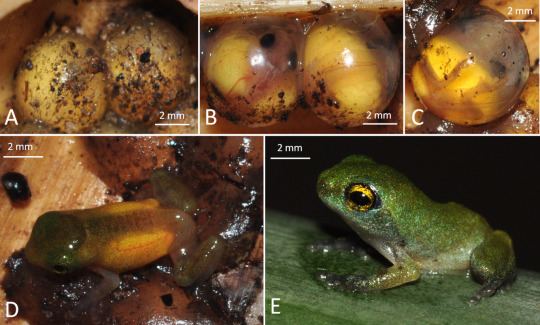
The caption from the paper:
“Stages in embryo development. A. Eggs past neural fold stage; B. Early stages of limb differentiation. Hind limbs seen as stubs and tail is well developed with venation; C. Complete limb differentiation. Digits fully developed. Tail length is reduced; D. Fully formed froglets emerged out of eggs and E. Froglet still remaining inside nest cavity. Notice colour change on dorsum and absence of yolk in abdomen.”
There’s still a lot unknown about direct development, but it’s certainly a major reproductive strategy utilised by a lot of Anurans.
The other day I found out that not all frog species go through the whole tadpole and metamorphosis thing. Probably not even *most* frog species. (This is called “direct development”.) The eggs just hatch into tiny fully-formed frogs.
I feel as if I have been lied to my entire life.
785 notes
·
View notes
Text
Hi there!
First of all, yes, squirrels are omnivorous. I think you’re in the UK but I’m not sure if you’re referring to the Eurasian red squirrel (Sciurus vulgaris) or the introduced Eastern gray squirrel (Sciurus carolinensis), but both are known to consume animal material.
But then I thought, maybe you’d like a little more information! After all, the primary diets of squirrels are seeds. So under what situations will squirrels eat animals?
Both the gray and red squirrels are opportunistic - they exploit different resources in their environments, and utilise alternative food sources as necessary. In spring and early summer seeds from the previous autumn become more scarce, so squirrels turn to alternate foods like nuts, buds, and animal products. Only about 3-7 of 50 red squirrel individuals over a few studies were found to have animal material in their stomachs though, so it’s not super frequent.
Why might you have seen a squirrel gnawing on a bone? Bone gnawing is seen in both gray and red squirrels, especially lactating females, as it’s an additional source of calcium. But there could be a whole host of reasons why a squirrel may be calcium deficient, and may turn to chewing on bones to supplement their diet.
Basically, the reason you saw this behaviour is probably because the individual you saw was seeking out additional calcium. You have nothing to be frightened of - rather, you should celebrate such a resourceful little rodent!
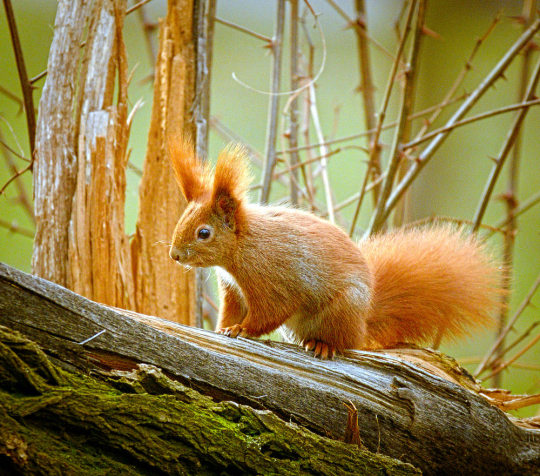
Photo: Red Squirrel | by hedera.baltica | CC BY-SA 2.0
hey uh are squirrels omnivores? bc I just saw one gnawing on a bone and I’m frightened
286 notes
·
View notes
Photo

3K notes
·
View notes
Photo
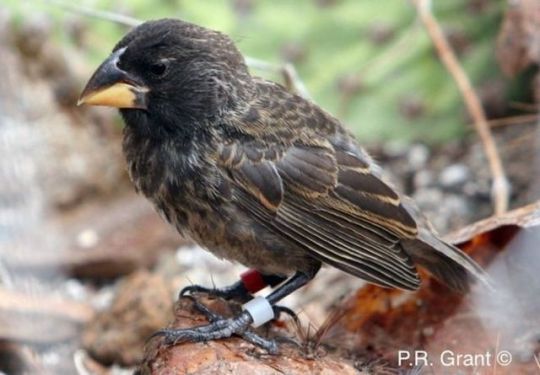
How long does evolution take to create a new species?
If you’re familiar with the concept of speciation (the development of a new species), you’ll probably be inclined to say, “Hundreds of generations!” A lot of factors have to fall into place for a new species to originate, and one of the very important parts is that the individuals of the species must be reproductively isolated - that is, unable to breed together to produce offspring, or for their offspring to be sterile, as with mules born from horses and donkeys. And this reproductive isolation is classically seen as taking a heck of a long time!
Or so we thought. A study published today in Science gives evidence of a new Galápagos finch species (image above, © author P.R. Grant) coming into existence and reaching reproductive isolation (not interbreeding with other species) in just three generations!
It all started when an immature male finch (Geospiza conirostris) ended up on the island of Daphne Major in 1981. Unable to return to his home, or reproduce with any birds of his own species, he bred with a female of one of the resident species (Geospiza fortis). Their offspring had differently sized bills and differently sounding songs to other resident birds, and so unable to find mates of their own, they bred with their siblings.
From this second generation onwards, all the birds acted differently to other birds on the island. In addition, they had differently sized bills which allowed them to exist in an unused competitive niche on the island.
Researchers followed the bird family for six generations. Generations 4-6 were all composed of a single sibling-mating in generation 3. Despite being inbred, these birds have high fitness - high survival and breeding success. And what’s really exciting is that all these birds now only breed with each other! This is what makes them reproductively isolated, and their very own species.
And in only 3 generations! As the authors say, "Charles Darwin would have been excited to read this paper."
You can read the full paper here.
And some news articles and media releases, too.
55 notes
·
View notes
Text
Oh man. Evolution is crazy (which is why it’s so amazing), and it would be impossible to give a full discussion here (not least because the field is still throwing us new curve balls and we still don’t fully understand it all ourselves anyway), but I’ll try and clearly go over the basics.
So, what is evolution? At its very base, evolution is the change of heritable characteristics (traits that we inherit from our parents) within biological populations (animals, plants, bacteria, viruses - basically any living thing) over successive generations.
Now, if that sounds confusing, that’s okay! Let’s take your monkeys as examples. In a population of monkeys, there is variation in a set of traits. Let’s say in our example, they have different tolerances to high temperatures. Some monkeys are best suited to temperatures below 35 degrees Celsius, but other monkeys can happily survive at 40 degrees. The offspring of the 35 degree monkeys also do better at 35 degrees - the offspring of the 40 degree monkeys also do better at 40 degrees. Now let’s say the temperature of the forest they’re in raises to 40 degrees. The monkeys that do well at 35 degrees start dying, but the 40 degree monkeys survive, and reproduce, and the population starts trending towards more monkeys that survive at 40 degrees over many generations. This is natural selection, and evolution!
Now imagine that the forest experiences an earthquake, and it divides the population of monkeys into two. One one side you have mostly 35 degree monkeys, and on the other, 40 degrees. If that separation lasts long enough, the two populations of monkeys go through evolution separately, and eventually become two different species, each with their own set of heritable traits. They still have the same ancestor, and that ancestor can still exist, but they are now all totally different to each other. It’s very gradual, and can take hundreds or thousands of generations.
Let’s look at a picture to examine the difference between Darwinian evolution and Lamarckian evolution:
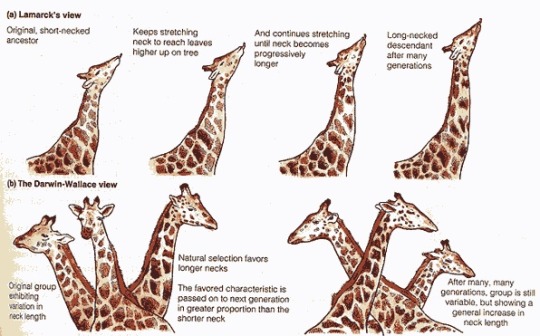
What I’ve described above is Darwinism - there is variation in traits in a population, and natural selection causes a higher proportion of the favoured or beneficial trait to become fixed in a population.
Lamarck argued that traits could change within a generation because of the environment (he had a lot of other theories as well, but let’s stick to this one for now). In high school, we’re taught that he was wrong, and that Darwin was right. “Giraffes can’t just grow their necks because they need to eat! They die if they can’t reach, and only the animals with longest necks breed and survive.”
But what we understand about biology now is that, actually, Lamarck was right about a lot of things. Animals and plants and living things can change their traits based on their environment. Have a look at this -
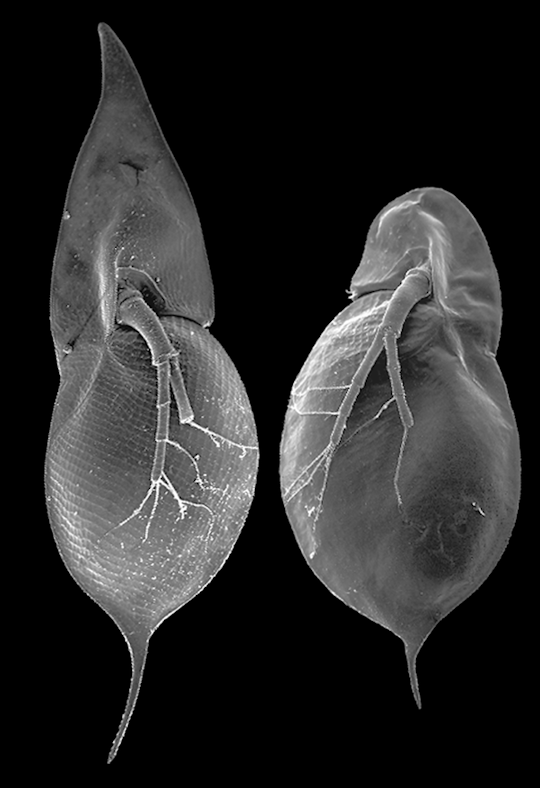
This is from a very famous paper by Agrawal et al (1999). These are Daphnia cucullata, tiny crustaceans known as water fleas. On the right, you have a normal animal. On the left is one with the exact same genes (it’s a clone), but after being exposed to predators. See how the environment has caused it to develop protection? And what’s really cool is that the offspring of those protected animals were born with higher defences, which means those traits were heritable. If you can get that over many generations, guess what? You have evolution!
The sum up here is that evolution is very gradual, and all about which traits allow a living thing to survive better in its environment, at least long enough to reproduce, and to give those useful traits to their offspring, and their offspring, and theirs and theirs and theirs for many generations.
Evolution can be pretty confusing, but it’s awesome. I know I haven’t answered all your specific questions - unfortunately I’m not a human evolution student - but I hope it’s given you a bit more background to help you understand it a little more.
I don’t understand evolution. Is it like one day, a monkey gives birth to a monkey that is different in some way, and that becomes a different type of monkey, and eventually one of those monkeys have one that becomes th new monkey? And we just gradually evolved like that into what we are now? Or did one day a monkey just suddenly gave birth to a human and then it became a thing? And in that case why didn’t those monkeys go extinct because they only had human babies? But wait aren’t we technically still evolving even right now because people’s appendixes are getting smaller and smaller and disappearing? At one point will we become so evolved as humans that we become the next evolutionary cycle?? Where does race come into this, how did different races evolve from Africans? Evolution is crazy
216 notes
·
View notes
Photo
In case you can't read the article via the picture -
Deakin researchers are pleading for beachgoers to keep their dogs on a leash after the discovery of dead hooded plovers in Barwon Heads. The body of a mauled chick was also found dumped in rubbish bin at the entry point to Barwon Head's 13th beach.
Wildlife and conservation biology associate professor Mike Weston said it was a shameful act and showed dog attacks could be a real factor in the decline of threatened hooded plovers.
"The battle to save threatened shorebirds which breed on our beaches rages every spring and summer, as thousands of Victorians and their dogs enjoy time at the beach, and the birds desperately try to breed," Prof Weston said.
"This is not a trivial matter. Beachgoers must obey the prevailing rules and regulations, particularly the leashing laws."
Deakin honours student Tom Schmidt said the discovery had left the team in utter shock.
"The entire time I was thinking to myself that this must be a mistake, how could a small, flightless chick of a threatened species end up in a bin?" he said.
"The tiny body was tied into a bag containing dog faeces and the injuries were consistent with dog attack.
"The dog walking community on our beaches needs to rise to the challenge, we need them to help save this species."
This species comes up a lot in lunch-time chats with my fellow ecologists at Deakin, Waurn Ponds, being so close to Barwon Heads and being conservationists ourselves, and it seems a common story that these birds are either being killed by dogs, or their nests disturbed and destroyed.
Hooded plovers (Thinornis rubricollis) are threatened species that nest on surf beaches - in Victoria, especially Ocean Grove and 13th Beach, but any sandy beach on the Bellarine Peninsula can have known nesting grounds.
From August to March, these birds nest in the sandy dunes. During this time, signage and temporary fences are put up to prevent access to nests, and to remind everyone to keep their dogs on leashes. Plover chicks cannot fly for their first five weeks, and forage alone up to 1 km from their nest - so unleashed dogs can cause serious havoc to them even outside the fencing.
“A simple formula of alerting beach users with signs and temporary fencing, putting out wooden teepees for chicks to hide in, and requesting dogs be on a lead, is enough to tip the balance and give these birds a 55% chance of having their family survive instead of a measly 2% chance.”
- City of Greater Geelong
If you live in or visit this region, please do your part and obey these rules to help conserve a non-aggressive, charismatic, defenceless threatened species.
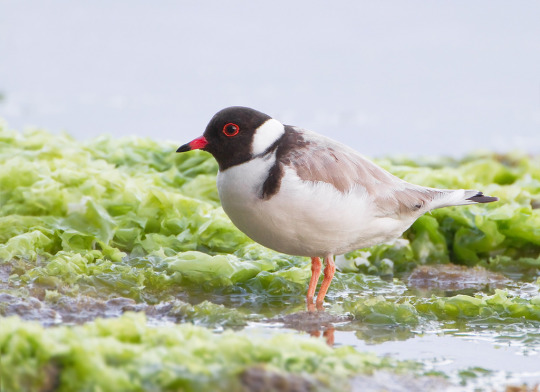
Photo: Hooded Plover | JJ Harrison | CC BY-SA 2.0

Deakin honours project discovers Hooded Plover chick apparently killed by dog.
66 notes
·
View notes
Photo
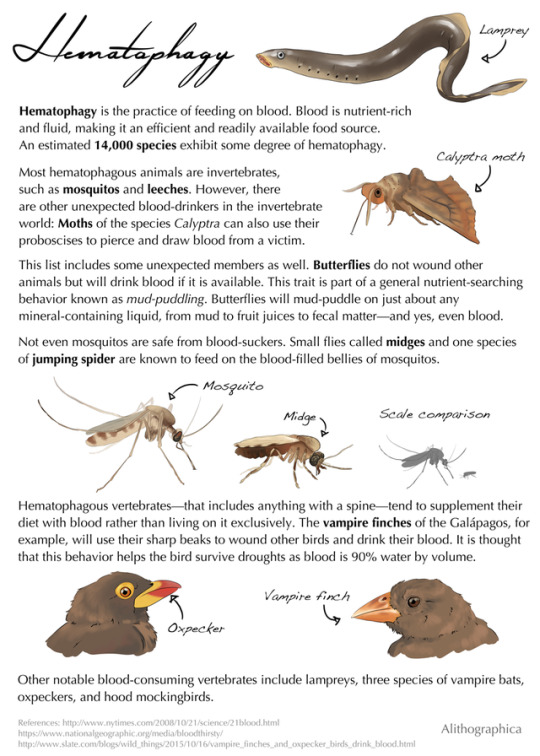
Science Fact Friday: Blood suckers!
(…Though most hematophagous animals don’t “suck” blood, they lap it up. Which is what vampire bats do, by the way - they just cut open a victim and lick the blood off. And out of the 1,400 species of bats, only 3 are vampire bats. Just to set the record straight.)
Support Science Fact Friday on Patreon!
959 notes
·
View notes
Note
A note on accessibility, because I couldn’t agree more -
Fortunately, more and more tertiary education institutions are pushing for a higher focus on scientific communication. Nowadays, this is becoming more frequently an option for a class, or even a requirement of graduate courses like Masters and PhDs. If you’re looking into doing graduate studies in science, I cannot recommend enough that you take a scientific communication subject, or many if possible, even if they aren’t a requirement for your degree.
Additionally, more and more employers are checking for a degree of scientific communication education or experience. It’s becoming harder to become employed without these skills. Community outreach, scientific journalism, or even blogs like these and the increasingly vital active Twitter accounts - these are all options we as scientists should be considering required experience.
One of our major responsibilities as researchers and scientists is to pass this information on to the general public - but they communicate differently to us and it’s so important to know how to transfer our knowledge to them.
What are your favorite/least favorite things about science?
I mean, there’s really nothing that’s not to like about science, so I’ll have to take a shot at scientific culture.
The worst thing about modern science is that it’s not accessible to the layman, which is counterproductive since science should be for everyone rather than just for people with higher education. Science impacts us all and it should be presented in such a way that doesn’t exclude people with less formal education. My least favorite thing to see in a paper or textbook is intentionally overcomplicated language which obscures the point being made. It’s elitist and obnoxious (as well as incredibly tedious to read).
That’s not to say that there’s no place for proper terminology, because it’s definitely a vital part of the sciences (particularly in the field of taxonomy), but there’s a difference between using correct terminology and purposely overcomplicating your ideas.
As for my favorite thing, lately it’s been the massive array of marine invertebrates that look like schlongs. Look what mother nature done did.
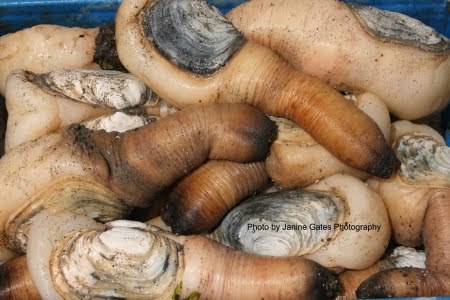
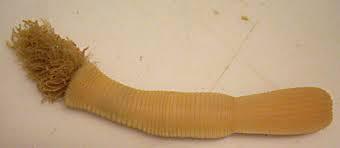

(top to bottom: geoducks, a priapulid, and an enteropneust)
54 notes
·
View notes
Text
This is a fantastic question, and when I read it my first thought was, Oh, wow. I HAVE to find out.
Let me preface by saying I’m not an entomologist, so all my information is coming straight from scientific papers, which means I could be interpreting things wrong based on the animal system – if an actual entomologist wants to jump in to correct anything I say, please feel free.
First of all, what is obesity? – In humans, it’s the excessive accumulation of body fat, which may have a negative impact on health. Can insects, and specifically ants, experience this?
In insects, lipids (fats) are stored in an organ called the fat body, which is used in excess energy storage, and metabolism. Importantly, the fat body is involved in the creation and use of energy reserves, including these lipids, depending on the current requirements of the animal, and the signals it’s receiving via hormones and enzymes. The fat body is found throughout the body, but mostly just under the integument (the ‘skin’, so to speak’), and especially around the gut and reproductive organ.

(Image Credit: Susumu Hirabayashi | CC BY 4.0)
So, when we talk about obesity in insects, what we’re looking at is excess lipids stored in the fat body.
Now, here’s the thing – a few insects have been found to be capable of displaying obesity, including dragonflies and small fruit flies, and it has been shown this can be linked to diet (such as through consuming excess sugar). In particular, these fruit flies – Drosophila – are a very common insect used in biomedical research, and this induced obesity and diabetes is very useful for helping to understand the human system.
What’s important, though, is that these examples are scientifically induced. Researchers made these insects obese. A search through scientific literature (although admittedly nowhere near an exhaustive one) didn’t show me any real examples of naturally occurring insect obesity, but this could be for several reasons –
It doesn’t occur naturally
It is difficult to identify externally
It hasn’t been examined
I did find one example of someone in 1909 describing an obese queen ant, but this seemed to be purely based on the fact that she had an enlarged abdomen, which could also have indicated hyper-fertility like the other nearby queens.

(Photo Credit: Laskis & Tschinkel | CC BY 2.5)
So, can ants be obese? Given other insects have been experimentally induced to be obese, and ants share the same organ in which this excess lipid is stored, yes, probably. But there doesn’t seem to be any example of it.
Can ants get obese?
45 notes
·
View notes
Note
How on earth do shiny exoskeletons form?
Exoskeletons are formed by layers of chitin formed from the epidermis. While most invertebrates get their colouration from pigments and reflect light like so:
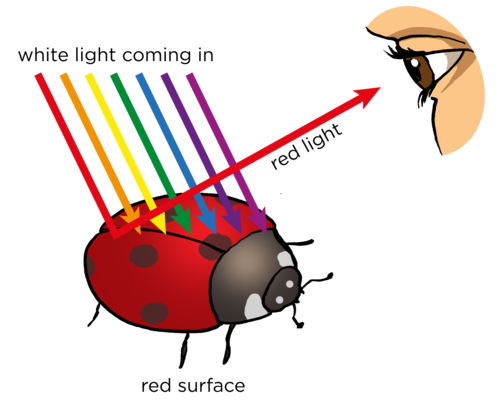
Inverts that have shiny exoskeletons get their colour and shine from the way the light interacts with the microscopic structures of their exoskeletons. The light that hits these structures is specular reflection, while light hitting normally pigmented exoskeletons is diffuse reflection (like above with the red lady beetle).

For example:
Chrysina gloriosa
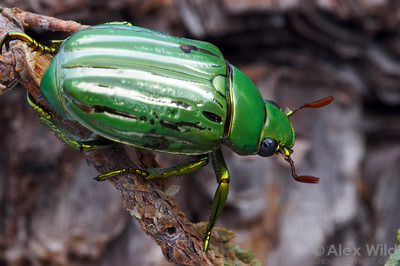
These beetles get their shine a liquid crystalline material produced on the external surface that assembles into three complex polygonal shaped structures: hexagons, pentagons and even heptagons. They selectively reflect left circularly polarized light on the beetles excoskeletons that gives that shiny and brilliant green appearance!
Here’s the research on this beetle and it’s shiny extoskeleton
Another example (another couple of coleoptera) Chrysina aurigans (gold) and Chrysina limbata (silver).

These beetles get their shiny excoskeletons from multilayer nanostructures allowing for that metallic shine appearance. Also to note these beetles are not iridescent! (this means they appear gold or silver from every angle).
These beetles exoskeleton’s are made up of over 70 layers of chitin and each have difference refractive indices that allows light waves to be reflected at each interface.
Read the full research paper here
Another example is the use of iridescence that can create that shine in excoskeletons (more beetles I know. But beetles are the largest order and have lots of good examples).
(a) Loxandrus rectus, (b) Phalacridae gen. sp., © Cicindela scutellaris scutellaris, (d) Amarygminae gen. sp., (e) Phanaeus vindex, (f) Eupholus sp.
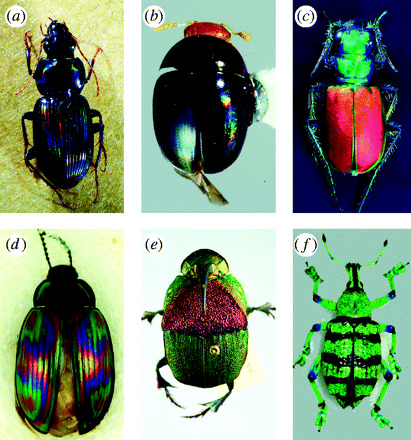
There are a number of structures and mechanisms that these beetles use to get their shiny exoskeletons.
Multilayer reflectors - that are thin layers of chitin that have difference refractive indexes and are spaced to one-quarter of the visible light wavelength.
Additive or ‘pointillistic’ colour mixing - where the external surface of the beetle is covered with an array of closely packed, minute punctae. That each individually reflect narrow bands of wavelengths
Circularly polarizing reflectors - Like explained already above in Chrysina gloriosa
Broadband reflectors - these are multilayer structures that reflects most or all wavelengths of light simultaneously
Three-dimensional photonic crystals - these crystal structures (found in scales on the exoskeleton) have closely-packed shapes; hexagonal, diamond lattice, pentagonal, ect, that reflect saturated colours and reduce the angle dependency. Colour is produced by the high ordered lattice in the scales. here’s what they look like (as shown in Pachyrrhynchus congestus pavonius).

Read more about that research on iridescence mechanisms here
1K notes
·
View notes
Text
Hi there!
This is something very, very dear to me, and so incredibly important, so I wanted to respond to you.
First off, it’s important to remember that so many of us in STEM have mental illnesses. I myself have depression and anxiety, half of my colleagues have some combination of symptoms, along with Imposter Syndrome, and PhD students have a major risk of mental illness as discussed in a major study and multiple articles this year.
To answer your question about successful people with mental illness, a very, very short list -
Isaac Newton is now believed to have shown symptoms of bipolar disorder.
Dr. Kay Redfield Jamison is a renowned clinical psychiatrist has bipolar disorder, and has written several books on famous people who also have it.
John Forbes Nash Jr. was a mathematician who received a Nobel Prize in Economic Sciences, and suffered paranoid schizophrenia.
Here’s the thing to remember. You are not alone in this. Your mental illness, even at its most debilitating, doesn’t have to prevent you being successful. If you pursue tech at higher education levels, I can thoroughly recommend that you find out about your options at your college or university, including Disability Services who can help tailor your education in a form you can handle. Also, if you end up with an advisor or supervisor in higher education and you think you can trust them, it’s worth letting them know. My supervisor has been privy to most of my health problems, including the moment I started getting treatment, and has been an absolute rock and brilliantly supportive during this time.
I hope you can find something similar. And I really hope you go for it. We need more women in tech, and I wish you the absolute best of luck.
I think I’ve gotten to the point now where there’s enough publicity and acceptance surrounding women in tech that it seems realistic for me to succeed. But when I think about my mental illnesses and how they limit my productivity, it seems unlikely that I’ll ever graduate and get a job in my field.
Does anyone know of people who succeeded in STEM fields despite debilitating mental illnesses? Or resources to help keep up with the pressures?
9 notes
·
View notes
Text
How to meet the basic needs for your pet rat!
I’ve noticed that many of the ratblr related tags are filled with people mistreating and not properly caring for their rats. First of all, I’m not going to sugar coat anything; It’s a sign of a bad pet owner to buy a pet without having done your proper research into what it requires to care for that animal.
Getting pet care information from a pet shop is dangerous and more often then not, the information they give out is just plain wrong, as well as the products they sell that are marketed for “rats” often don’t meet the basic requirements for rats. The people that work at these shops want to make money, and most often they have no prior animal specific training or education. So it is up to you to properly research the care required for rats.
Since I see a lot of people apparently incapable of doing their own research, I’ll be walking through the basic requirements for pet rats. Note that these are only the BASIC requirements, and you should be providing above this.
THE RATS
First of all, you should NEVER ever have only one rat. There is no excuse to housing only one rat (save for temporary medical reasons or behavioral issues). If you only want one pet rat, then I’m sorry rats are not the pet for you!
Rats are highly social animals, they require large social groups. Most would suggest having at least TWO pet rats at a time, but to be quite honest I feel that you should have at least THREE rats at one time.
Your rats should also be kept in either female or male groups to avoid unwanted pregnancy and fights. Unless the rats are desexed, in that case mixed groups of rats do really well together. There’s both pros and cons to having either female or male rats, that you should take into consideration.

Male rats tend to grow MUCH larger, so keep that in mind. The rat on the left is female and the rat on the right is a male.
Male rats also tend to be much more lazy and cuddly, and will spend some of their time napping and eating. They secrete buck grease (orange-y in appearance, as shown below) that can often cause their backs to be oily due to their levels of testosterone.

Female rats are much more “active.” They tend to want to run around, play and explore a whole lot more then male rats do. They’re also a lot smaller then the males (and minus the huge balls that male rats have. If you don’t like the idea of huge naked rat balls dragging over you, you may want female rats instead). They also go into heat often, so will get a little rowdy; mostly this just includes lots of humping between the cage mates. (if your female rats are humping each other don’t worry. It’s normal and there’s nothing you can do to stop it. And you shouldn’t aim to stop normal, healthy, behaviours if it’s not hurting the pet).
Also keep in mind that your pet rats need to be handled daily, and let out of their cage for a run around / social time with you. So you’ll need an area that is safe for your rats to free roam (under supervision). This means, making sure there isn’t anything they can chew through (wires, clothes, shoes), escape from, or get into, that you don’t want them to.
CAGE
Okay this is the biggest issue I see people have with their pets. So this is going to be a long one, so buckle down.
SIZE
Firstly, the size of the cage. Those cages that pet shops market as “rat” cages are not at all suitable for rats.
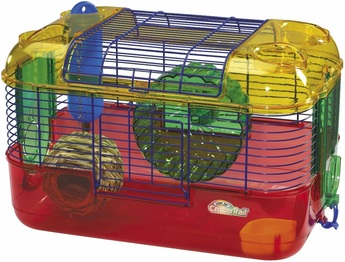
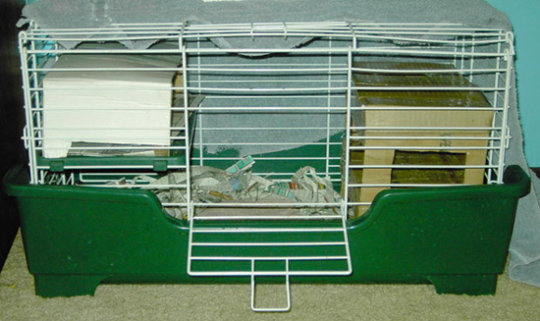
These cages are not at all big enough for rats. The rule of thumb is that each rat requires 2 cubic feet per rat. This rat cage calculator is a great tool, where you can either put the dimensions of a cage or the number of rats you have, and it’ll calculate their how many rats you can fit into that cage, or the size cage required.
Rats need a lot of space! A rat cage like this one (below) can only fit two rats.
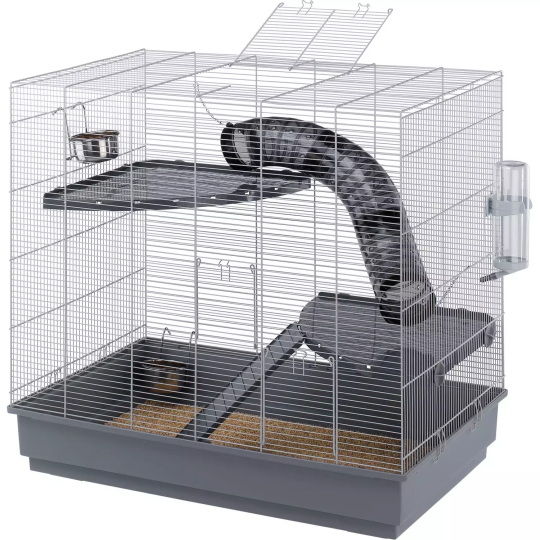
This cage could probably only fit about 4-5 rats

While a large cage like this one (below) could fit up to 6-7 rats!

TYPE - wire, plastic, glass?
Rats should be kept in wire cages. Glass and plastic tanks / cages (shown below) are all bad enclosures (for a whole number of reasons but we’ll focus on the type for now).



Glass and plastic tanks don’t have enough ventilation and can result in a build up of ammonia (from urine), smell and temperature. Not only that but they don’t offer the rats any way to climb (as well as all of these being too low in the first place).
Rats like to climb, and wire cages offer them the ability to do this, as well as having better air flow and less risk of them chewing through the cage and escaping.
SUBSTRATE
This is another big one, that I see people not doing correctly. Rats are very prone to respiratory infections and this tends to mostly be caused by the type of substrate used in their cage. The above photos all use wood shavings / straw as a substrate. Wood shavings are terrible for rats, they are filled with dust, mites, parasites, they don’t really help soak up urine and they tend to make the smell worse.
Some alternatives include covering the floor with fabric, that can be washed. This in my opinion isn’t the best, as they tend to get really dirty within the first few hours after cleaning the cage. They’re also not fun to wash.

Another opinion is paper kitty litter (like the one below). It’s good for soaking up urine and helps a lot with smell in general.

I personally use newspapers to line the cages. My rats also like to rip it up and use it as bedding for their nests and it’s cheap and easily available.
COVERING PLATFORMS
Another huge thing I see rat owners do is have uncovered wired platforms. You need to cover all the platforms that are not solid (aka wired). These can be covered in fabric (again I tend not to use fabric anymore personally, as they get dirty quickly and my rats loved to chew the hell out of it), paper, or some sort of plastic covering (though you need to make sure your rats aren’t chewing the plastic, in case they swallow any).

If wired platforms aren’t covered, your rats will have a good chance of developing bumblefoot; a painful condition caused by the inflammation and/or infection of the surface and connective tissue of the feet (as shown below).
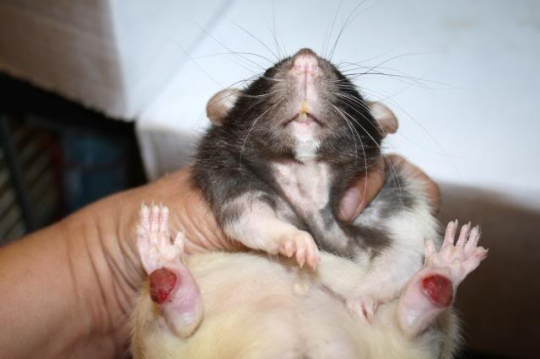
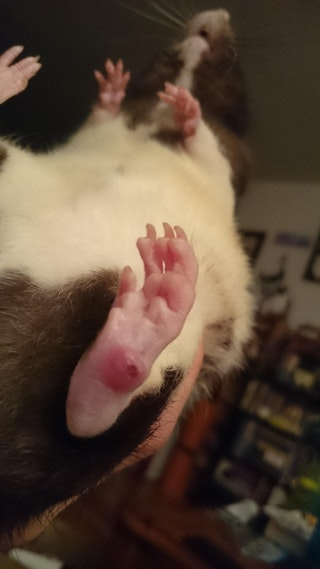
TOYS, BEDS AND HAMMOCKS
Again, most of the photos shown in rat related tags have pretty bare cages. You cannot put a few platforms, one hammock, water bottles and a food dish in a cage and call it a day. That’s lazy and bad pet care.
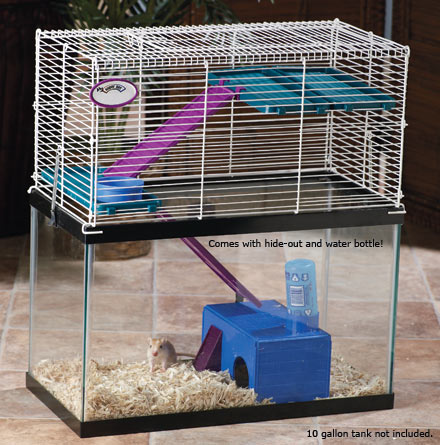
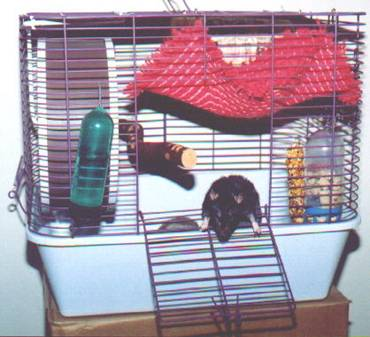
Rats require lots and lots of toys, beds, hammocks, places to hide / sleep / nest and chew / destroy. (as well as litter boxes if you’d like to litter train your rats, which I suggest you do. It’ll make cleaning easier).



All the above cages are really good examples of cage set up’s that rats require. And no these cages aren’t “over the top”, these cages are the basic requirements for rats. if you can’t provide these sorts of set ups, then pet rats aren’t for you.
HYGIENE
Rats can be destructive. They’ll like to tear things up and chew through everything, flick food everywhere and pee on literally every part of their cage, including their cage mates. So you need to be cleaning their cage out at least once a week but ideally twice a week, depending on how messy the cage gets.
The rats themselves don’t really require much bathing. Rats themselves are actually pretty clean, and spend a lot of time grooming themselves and each other. However they will pee on each other and they can get dirty (especially males with lots of buck grease). You shouldn’t really be washing them any more then monthly. When washing rats, use only a tiny bit of something like baby shampoo, and make sure that you don’t get their ears wet, as it can lead to ear infections.
FOOD
Feeding rats can be quite expensive. They require high quality specific rodent feed / lab blocks (low quality feed will have fillers like corn, which aren’t that great for your rats, and are often pretty dusty which can cause respiratory infections). On top of the feed, they require (often daily) fresh veggies, fruit, protein (eggs are a good source. And it’s fun watching your rats eat their way through a hard boiled egg) and carbs (such as pasta).
Male rats cannot be fed any sort of citrus fruit; it’s bad for their health in the long term, often leading to cancer or UTI’s.
ILLNESS AND DISEASE
Rats and really prone to disease and illness. Most commonly respiratory infections, cancer, tumours, UTI’s, bumblefoot. They will require trips to the vet, so if you cannot afford to take your pet to the vet; and this often means a specialised small animal vet (as not every vet will be able / have experience with rats) then you should not have or be considering getting a, pet.
EXPENSES AND MONEY
Lastly I want to get mention expenses and money. Most people will use the excuse of not taking their rat to the vet because of lack of money, their parents won’t let them, ect.
I’m going to be brutally honest. You shouldn’t have a pet then. This obviously doesn’t include people going through sudden financial crisis or are hit with a sudden very expensive vet bill, ect.
But if you cannot afford to buy a cage, toys, proper food, equipment, and vet bills to provide your pet rats with their basic care, then you aren’t ready to have a pet and you shouldn’t have one. To buy a pet, when you know you are unable to properly provide it with care, is selfish.
#this is incredibly useful and thorough!#animal husbandry#animal welfare#pet care#rat care#fancy rat#pet rat#perhaps worth adding something about appropriate containers for vet trips?
1K notes
·
View notes
Photo

A rare yellow lobster—so rare the chances of finding one is 1 in 30 million — was just donated to the Aquarium by Salem’s Patriot Seafood. Now it’s just one of several colorful crustaceans that could make an appearance during our live animal presentations.
#yellow #colorful #crustacean #lobster #americanlobster #homarusamericanus #1in30million #lobstertails #lobstertales #newenglandaquarium #boston #massachusetts (at New England Aquarium)
605 notes
·
View notes
Note
Just to follow up as well, I have a great deal of respect for the vets at Tufts University, particularly those involved in the clinical nutrition group. Here’s an excellent and brief article discussing some considerations regarding wet/dry food.
The sum ups:
“[...] outside of cats with kidney disease or urinary tract disease, there is no good evidence that the type of diet makes a difference in overall health. Therefore, once you’ve introduced canned food to your kitten initially, you can decide whether you want to feed all canned, a combination of canned and dry, or all dry food.” (Emphasis added by me.)
“In the end, in the absence of health concerns, either dry or canned food or a combination can be fed to cats or dogs and you should make this decision based on your pet’s individual needs, and your lifestyle, budget, and other factors.”
Do you know why some cats just hate eating the meat in wet food? My catto just licks the liquid off and wastes the rest. Is there some evolutionary aspect to this or is my cat just a little jerk to me
My first thought is that it’s just preference. Like people, some cats might not like the texture or taste of wet food, or they’re just used to eating dry. I can’t seem to find any specific research so it’s likely that it is just preference. Either way your cat isn’t trying to be a jerk, they just don’t like wet food or aren’t used to the texture of it.
Which, despite what some people may tell you, is perfectly fine. Your cat can live off dry only food, just make sure you have lots of sources of water for your cat to drink. As long as you do that and are feeding a high quality dry pet food, your cat should be purrfectly happy.
28 notes
·
View notes
Photo



These are a few of the species I have recently had accepted for publication, so they will be receiving names in the next few months!
381 notes
·
View notes